Stretch, Breathe, Grow: Simple Yoga Poses Every Kid Can Master (And Love!)
- Teachers
- March 4, 2025
- Viva Education
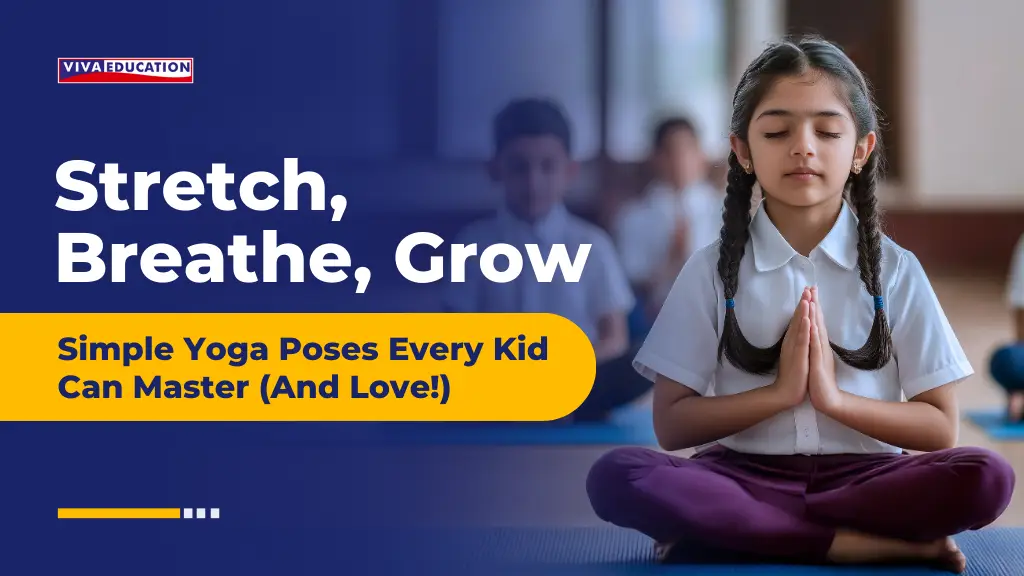
We live in a world that bombards children with constant stimulation, from screens to schedules. With teens averaging a staggering 9 hours of entertainment screen time daily, and a concerning rise in childhood anxiety and decreased physical activity, it’s no wonder they struggle with focus, anxiety, emotional regulation, and even physical health issues like increased risk of obesity.
This ‘physical excess’ of sedentary screen time, coupled with mental overload, creates a critical need for balance. That’s where the beauty of structured yoga sequences for kids comes into play. Teaching yoga to kids, however, isn’t always a walk in the park. Short attention spans and boundless energy can present unique challenges.
But by crafting engaging and age-appropriate flows, we can harness their enthusiasm and guide them towards inner peace, physical strength, and emotional resilience, offering a vital counterbalance to the pressures of today’s world.
Understanding the Benefits of Yoga Sequences for Kids
Yoga helps kids build strength, flexibility, and balance, making everyday movements easier and more controlled. It improves posture and coordination, helping them move with confidence. Deep breathing exercises enhance lung capacity and teach kids how to manage stress.
Mentally, yoga sharpens focus, boosts memory, and improves concentration—key skills for learning and problem-solving. It also promotes self-awareness and emotional control, helping kids stay calm under pressure.
Beyond the individual benefits, yoga encourages teamwork and connection. Group poses and activities create a sense of belonging, making it a fun, inclusive practice where every child can thrive.
Creating Effective Yoga Sequences for Different Age Groups
- Preschool (3-5 Years): Keep it short, sweet, and playful. Use animal poses like “Cat-Cow” and “Downward Dog,” and weave them into a fun story. Visual aids are crucial, so use cartoon illustrations of the yoga poses.
- Elementary School (6-10 Years): Introduce more structured flows, like a modified “Sun Salutation.” Incorporate partner poses and yoga games for kids to keep them engaged. Example Sequence: Tadasana, Forward fold, Low Lunge, Downward dog, Baby Cobra.
- Preteens/Teens (11-14 Years): Challenge them with advanced poses like “Warrior variations” and “balance poses.” Encourage them to create their own sequences, fostering creativity and ownership. Yoga flow for kids at this age can be a powerful tool for self-discovery.
Step-by-Step Guide to Designing a Kids Yoga Flow
- Warm-up: Start with simple stretches and yoga breathing exercises for kids. Light cardio, like jumping jacks, can get their blood flowing.
- Active Poses: Create a dynamic yoga flow for kids with standing, balancing, and dynamic poses. Smooth transitions are key. Example poses: Warrior 1, Warrior 2, Tree Pose, Dancer Pose.
- Calming Poses: Transition to seated and reclining poses for relaxation. “Child’s Pose” and “Savasana” are excellent choices.
- Cool-down and Relaxation: End with a guided relaxation or meditation. Positive affirmations can leave them feeling empowered.
Popular Yoga Poses for Kids: Building Strength, Balance, and Inner Peace
These poses are tools for empowering children, fostering self-awareness, and cultivating a sense of calm.
Warrior Pose (Virabhadrasana):
Instructions:
- Begin in Mountain Pose (Tadasana).
- Step your left foot back, turning it slightly outward.
- Bend your right knee to a 90-degree angle, ensuring it’s aligned with your ankle.
- Extend your arms parallel to the floor, palms facing down.
- Engage your core and gaze forward.
- Hold the pose for a few breaths, then repeat on the other side.
Benefits:
- Strengthens legs, ankles, and core muscles.
- Improves balance and stability.
- Builds confidence and inner strength.
- Teaches children to feel strong and grounded.
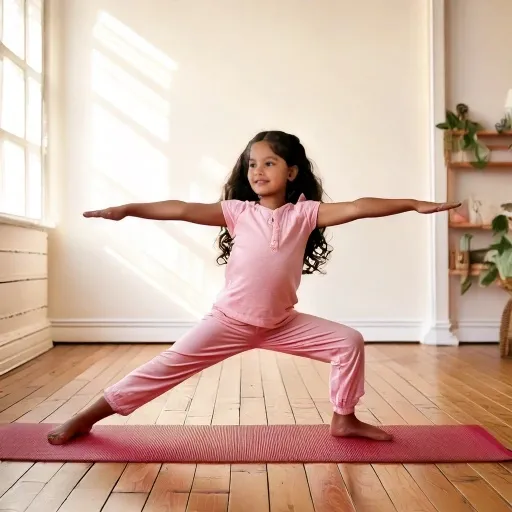
Tree Pose (Vrksasana):
Instructions:
- Begin in Mountain Pose (Tadasana).
- Shift your weight to your right foot.
- Place the sole of your left foot on your inner right thigh or calf (avoid the knee).
- Bring your hands together in front of your chest or extend them overhead.
- Find a focal point and hold the pose, maintaining balance.
- Repeat on the other side.
Benefits:
- Improves balance and coordination.
- Enhances focus and concentration.
- Calms the mind and reduces anxiety.
- Helps to build a sense of calm and focus.
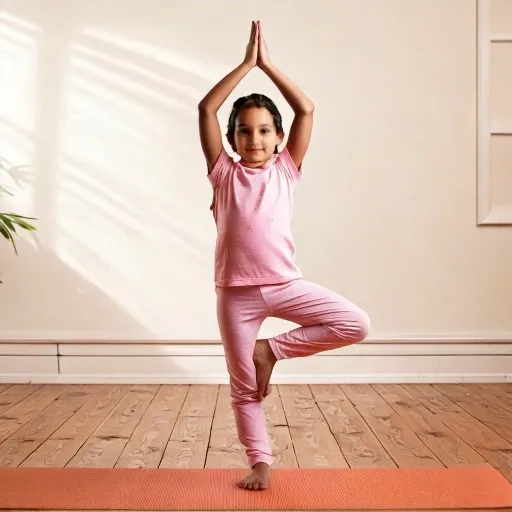
Downward Dog (Adho Mukha Svanasana):
Instructions:
- Start on your hands and knees.
- Tuck your toes and lift your hips up and back, forming an inverted “V” shape.
- Press your hands and feet into the ground, lengthening your spine.
- Relax your neck and gaze towards your feet.
- Hold for several breaths.
Benefits:
- Stretches hamstrings, calves, and spine.
- Strengthens arms and shoulders.
- Energizes the body and calms the mind.
- Releases tension.
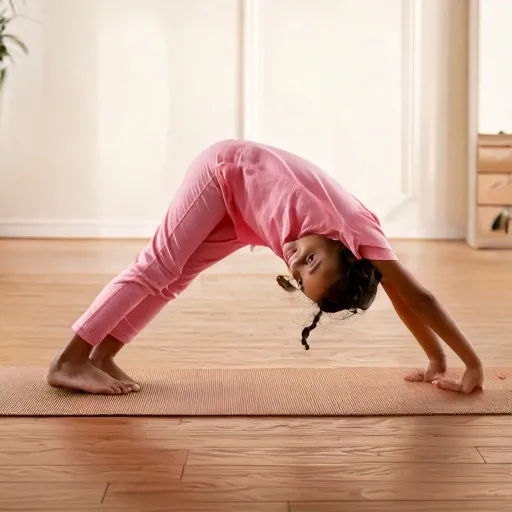
Cobra Pose (Bhujangasana):
Instructions:
- Lie on your stomach with your hands placed under your shoulders.
- Press your hands into the ground and lift your chest off the floor.
- Keep your elbows slightly bent and your shoulders relaxed.
- Gaze forward or slightly upward.
- Gently lower back down.
Benefits:
- Strengthens back muscles and opens the chest.
- Improves posture and spinal flexibility.
- Stimulates the digestive system.
- Helps to open up the chest, and improve breathing.
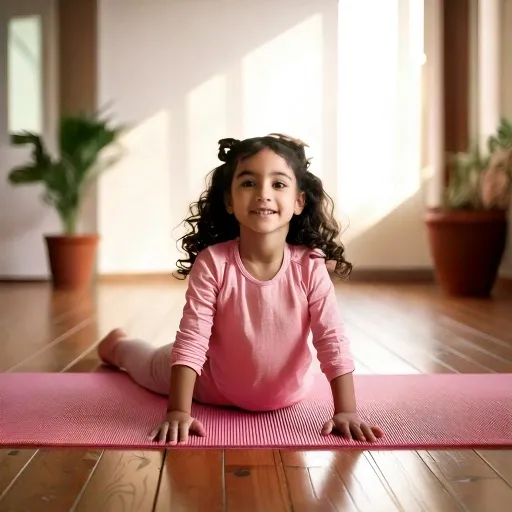
Child’s Pose (Balasana):
Instructions:
- Kneel on the floor with your big toes touching.
- Sit back on your heels (if comfortable) and fold forward, resting your forehead on the ground.
- Extend your arms forward or rest them alongside your body.
- Relax and breathe deeply.
Benefits:
- Calms the mind and relieves stress.
- Stretches the back, hips, and thighs.
- Promotes relaxation and inner peace.
- A great pose for taking a break, and calming down.
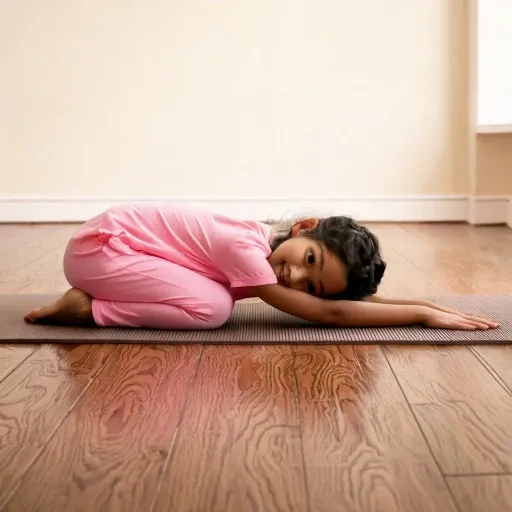
Garland Pose (Malasana):
Instructions:
- Stand with your feet slightly wider than hip-width apart.
- Squat down, keeping your feet flat on the ground.
- Bring your hands together in front of your chest.
- Use your elbows to gently press your knees apart.
- Hold for several breaths.
Benefits:
- Stretches hips, ankles, and groins.
- Improves digestion and elimination.
- Grounds the body and calms the mind.
- Helps to open up the hips.
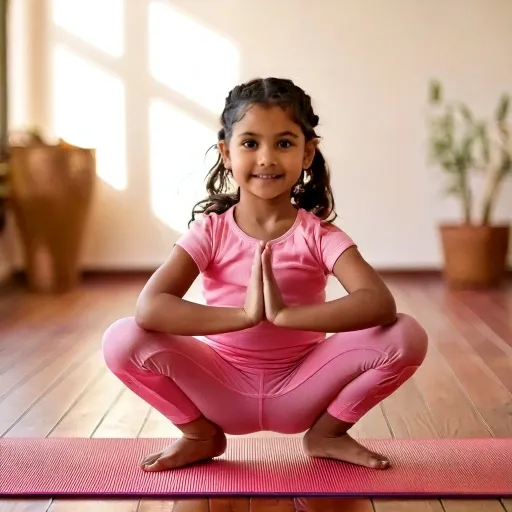
Chair Pose (Utkatasana):
Instructions:
- Begin in Mountain Pose (Tadasana).
- Bend your knees as if sitting in a chair, keeping your knees behind your toes.
- Extend your arms forward or overhead.
- Engage your core and maintain a straight back.
- Hold for several breaths.
Benefits:
- Strengthens legs and core muscles.
- Builds stamina and endurance.
- Improves balance and coordination.
- Helps to build leg strength.
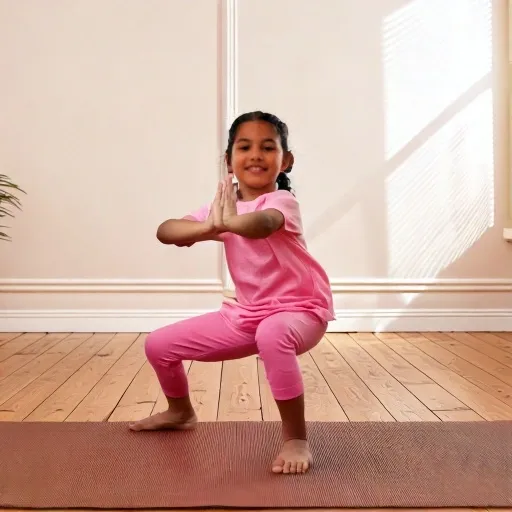
These poses, when practiced regularly, can contribute significantly to children’s physical, mental, and emotional well-being. Remember to create a fun and supportive environment where children feel comfortable exploring these poses at their own pace.
Incorporating Mindfulness and Breathing Exercises: Cultivating Inner Calm
Mindfulness and breathing exercises are the cornerstones of a truly beneficial kids yoga practice. They equip children with invaluable tools for managing stress, regulating emotions, and enhancing focus.
1. Yoga Breathing Exercises for Kids:
- “Belly Breathing” is a foundational technique. Encourage children to place their hands on their bellies and feel them rise and fall with each breath. This simple act cultivates a sense of grounding and calm. Explain that when they are feeling worried, they can use this kind of breathing to feel better.
- “Lion’s Breath” is a fun and expressive exercise that releases tension and promotes emotional release. Have children inhale deeply, then exhale forcefully with a “ROAR,” sticking out their tongues. This playful approach helps them let go of pent-up energy and emotions.
- “Alternate Nostril Breathing” can be turned into a game by saying that they are balancing the two sides of their brain. This helps them calm down and focus.
- It’s important to make the breathing exercises engaging and relatable. Use metaphors like “breathing like a flower” (inhaling the sweet scent) or “blowing out candles” (exhaling forcefully).
2. Guided Meditations and Visualization Exercises:
- These exercises transport children to a world of peace and tranquility, fostering a sense of inner calm. Use guided imagery to create vivid and engaging scenarios, such as exploring a peaceful forest, floating on a cloud, or visiting a magical garden.
- Tailor visualizations to children’s interests and imaginations. For example, if they love superheroes, guide them through a visualization where they embody their favorite hero’s strength and courage.
- Keep meditations short and age-appropriate, gradually increasing the duration as children become more comfortable.
- Use calming music and soft tones to enhance the experience.
3. Mindful Movement and Sensory Awareness Activities:
- These activities encourage children to connect with their bodies and surroundings, fostering a sense of presence and awareness.
- Engage their senses through activities like mindful walking (paying attention to each step), sensory exploration (feeling different textures), or mindful eating (savoring the taste and texture of food).
- Incorporate mindful movement into yoga flows, encouraging children to pay attention to the sensations in their bodies as they move through each pose.
- For example, during a standing pose, ask them to feel the connection of their feet to the ground, the length of their spine, and the openness of their chest.
Making Yoga Fun: Games and Activities: Transforming Practice into Play
Children learn best through play, so incorporating games and activities into yoga classes is essential for keeping them engaged and motivated.
1. Yoga Games for Kids:
- “Yoga Freeze Dance” combines movement and mindfulness, challenging children to hold yoga poses when the music stops.
- “Yoga Charades” adds a creative twist, encouraging children to act out yoga poses and guess each other’s actions.
- “Yoga Story Dice” where you have dice with yoga poses on them, and they roll the dice to see what pose comes next.
- “Yoga Musical Chairs” using yoga poses instead of chairs.
- These games not only make yoga more enjoyable but also reinforce pose recognition and promote social interaction.
2. Story-Based Yoga Adventures:
- Weave yoga poses into imaginative stories, taking children on exciting adventures through enchanted forests, underwater kingdoms, or outer space.
- Use props, music, and sound effects to enhance the storytelling experience and create a truly immersive environment.
- Story-based yoga adventures spark children’s imaginations, making yoga more engaging and memorable.
3. Partner Yoga Challenges:
- These challenges encourage teamwork, cooperation, and communication.
- Partner poses like “Double Tree Pose” or “Back-to-Back Breathing” foster a sense of connection and shared experience.
- Create fun and engaging challenges that encourage children to work together and support each other.
Tips for Teaching Successful Kids Yoga Classes: Creating a Nurturing Environment
Teaching kids yoga requires a unique approach that prioritizes fun, engagement, and safety.
1. Create a Positive and Supportive Environment:
- Foster a sense of community and belonging, where children feel safe to express themselves and explore their bodies.
- Use positive reinforcement and encouragement, celebrating children’s efforts and progress.
- Create a non-competitive atmosphere, where children are encouraged to focus on their own personal growth.
2. Use Props and Visual Aids:
- Props like yoga blocks, straps, and blankets can make poses more accessible and engaging.
- Visual aids like flashcards, posters, and books can help children learn and remember yoga poses.
- Use colorful mats, and fun music.
3. Adapt Sequences to the Needs of the Children:
- Be mindful of children’s age, abilities, and interests, and tailor yoga sequences accordingly.
- Offer modifications and variations of poses to accommodate different levels of experience and physical abilities.
- Create a flexible and adaptable class structure that allows for spontaneity and creativity.
4. Encourage Creativity and Self-Expression:
- Allow children to personalize their yoga practice by creating their own poses, sequences, or stories.
- Encourage them to express their emotions and feelings through movement and breath.
- Foster a sense of ownership and empowerment by giving them choices and opportunities to lead.
5. Ensure Kids’ Yoga for Kids Classes Don’t Clash with Sleep/Play Times:
- Children need to have a good balance of activity and rest.
- A class right before nap time, or bed time might make the child over tired, or unable to sleep.
- Also, missing play time might make the children resent the yoga class.
6. Demonstrate Asanas Rather Than Explain Them:
- Children learn better by visual demonstration.
- Use clear and concise cues.
- Move around the room to insure proper alignment.
7. Challenge Children Appropriately:
- Offer age-appropriate challenges to keep children engaged and motivated.
- Introduce new poses and sequences gradually, building upon their existing skills and knowledge.
- Celebrate their achievements and encourage them to strive for continuous improvement.
8. Avoid Comparing Kids:
- Focus on individual progress rather than comparing children to each other.
- Emphasize the importance of self-acceptance and self-compassion.
- Create a supportive and inclusive environment where every child feels valued and appreciated.
Bringing Yoga and Mindfulness into Learning
The benefits of yoga sequences for kids are profound and far-reaching. By incorporating yoga into their lives, we’re giving them a gift that will serve them well into adulthood. So, let’s embark on this journey together, creating a world where children thrive, both inside and out.
At Viva Education, we’re committed to empowering the next generation with holistic learning experiences. Our new range of educational services integrates movement, mindfulness, and well-being into the learning journey, helping children develop focus, confidence, and emotional resilience.
If you’re an educator, parent, or school looking to incorporate structured yoga and mindfulness programs into your curriculum, we’re here to support you. Join us in shaping a future where children not only learn but thrive!
Get in touch today to explore our new offerings and bring the benefits of yoga and mindful movement into your learning environment.
>> Please Share


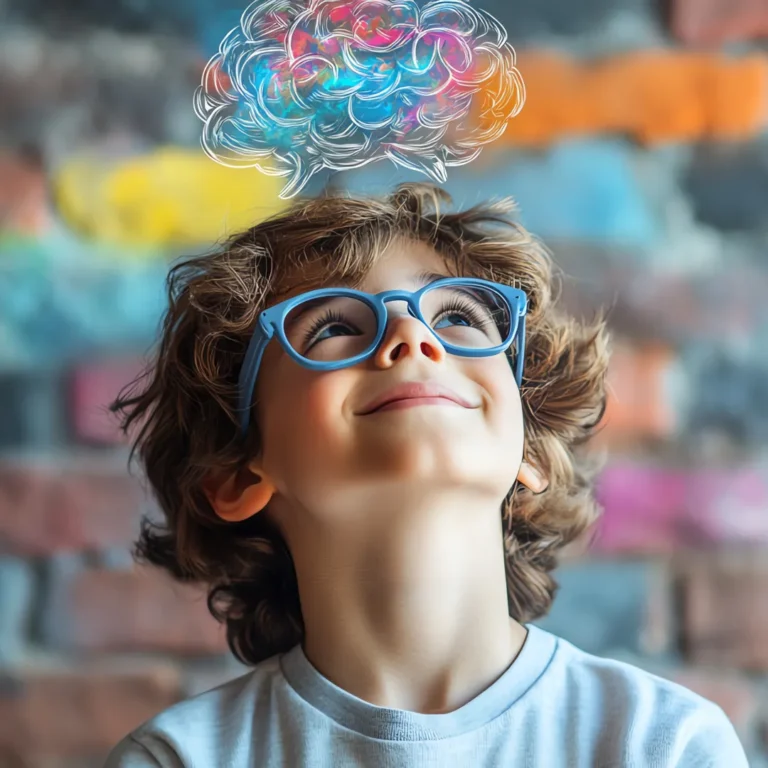

Nice post